最近收到了Nordic最新的旗艦級BLE芯片 nRF54L15的開發板,大概研究了一下,今天教大家怎么在上面把BLE跑起來。
前言:開發板概覽
1、打開包裝之后里面是用防靜電袋包裝的開發板和NFC天線,nRF54L15DK的代號是PCA10156,但是nRF54L15的開發板對比nRF52832的開發板來看,nRF54L15的開發板沒有再采用Arduion接口將IO引出。開發板上用到的元器件也少了很多,看下來只用到五顆主芯片。
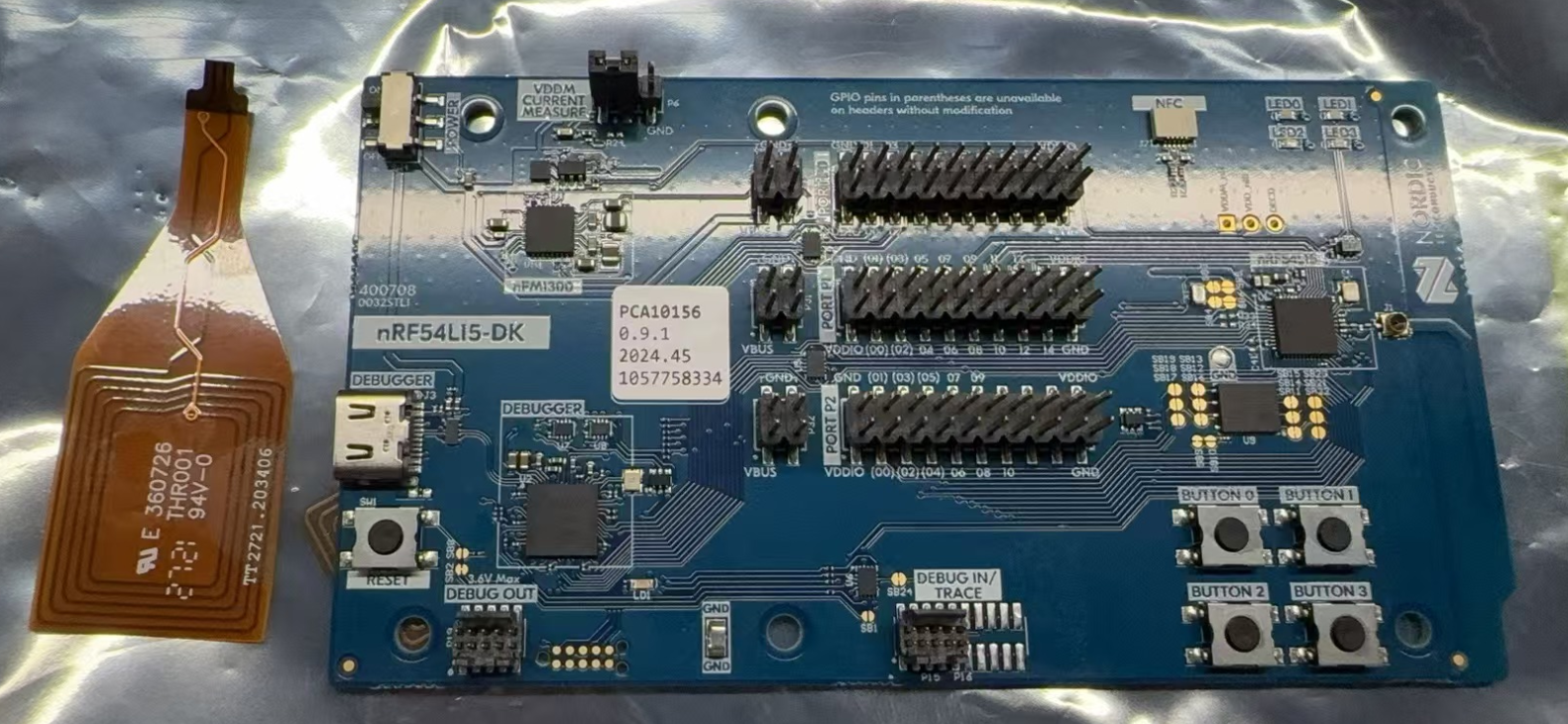
開發板的JLINK芯片用的是Nordic的nRF5340,JLINK的USB口換成了Typc-C口。
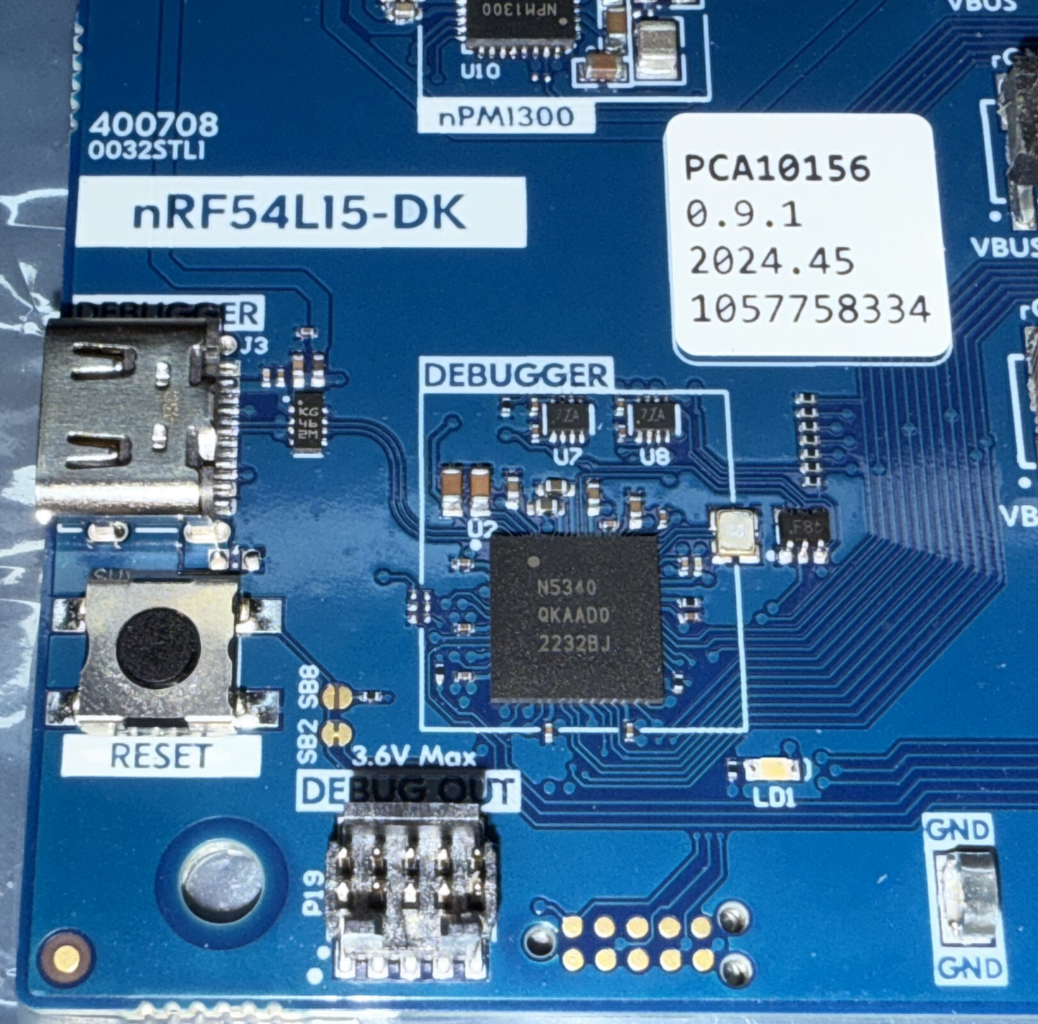

最后來看一下nRF54L15部分,這里外掛了一個MXIC 64Mbit的flash,nRF54L15最小系統的元器件也少了很多。
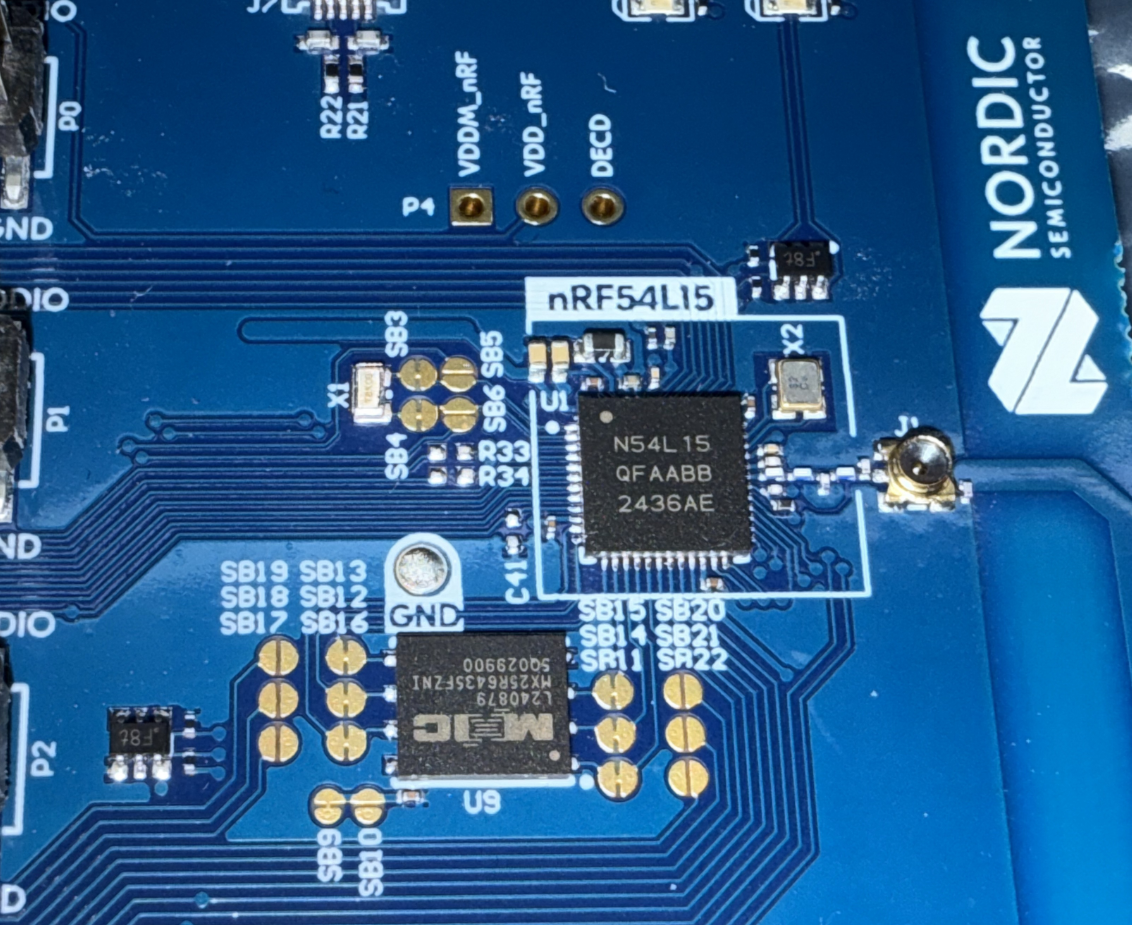
在網上可以找到nRF54L15的資料:
介紹:https://www.nordicsemi.com/Products/nRF54L15
規格書:https://docs-be.nordicsemi.com/bundle/ps_nrf54L15/attach/pdf/nRF54L15_nRF54L10_nRF54L05_Datasheet_v0.7.pdf
硬件設計:https://www.nordicsemi.com/-/media/Software-and-other-downloads/Reference-Layouts/nRF54L15/nRF54L15-QFAA-Reference-Layout-0_7.zip
2、環境搭建
根據我原廠的朋友的說法,新的nRF54L15需要用到NRF Connect SDK去開發,
這里環境搭建可以參考官方的文檔:Installing the nRF Connect SDK (nordicsemi.com)
最新的文檔已經推薦使用nrfutil來下載SDK了,但是我個人還是更喜歡用west的方式
這里可以參考中國區原廠FAE的博客:開發你的第一個nRF Connect SDK(NCS)/Zephyr應用程序 - iini - 博客園 (cnblogs.com)
按照博客中的方法安裝好Choco和相關的工具之后,直接執行下面兩條命令即可:
west init -m https://github.com/nrfconnect/sdk-nrf --mr v2.9.0
west update
nRF54系列的SDK要使用NCS 2.7.0及以上的版本,下載SDK的時候需要注意。
NRF CONNECT SDK現在的編譯環境也換成了VS Code + Nordic插件的方式,這里的編譯環境搭建也可以參考上面中國區原廠FAE的博客。

一、在nRF54L15D上運行你的第一個程序
1、搭建好環境之后,首先我們從SDK中Copy一個Hello World的工程

2、編譯在NRF54L15DK上運行,這里需要注意NCS2.7.x及以上的版本在編譯的時候需要選擇SysBuild
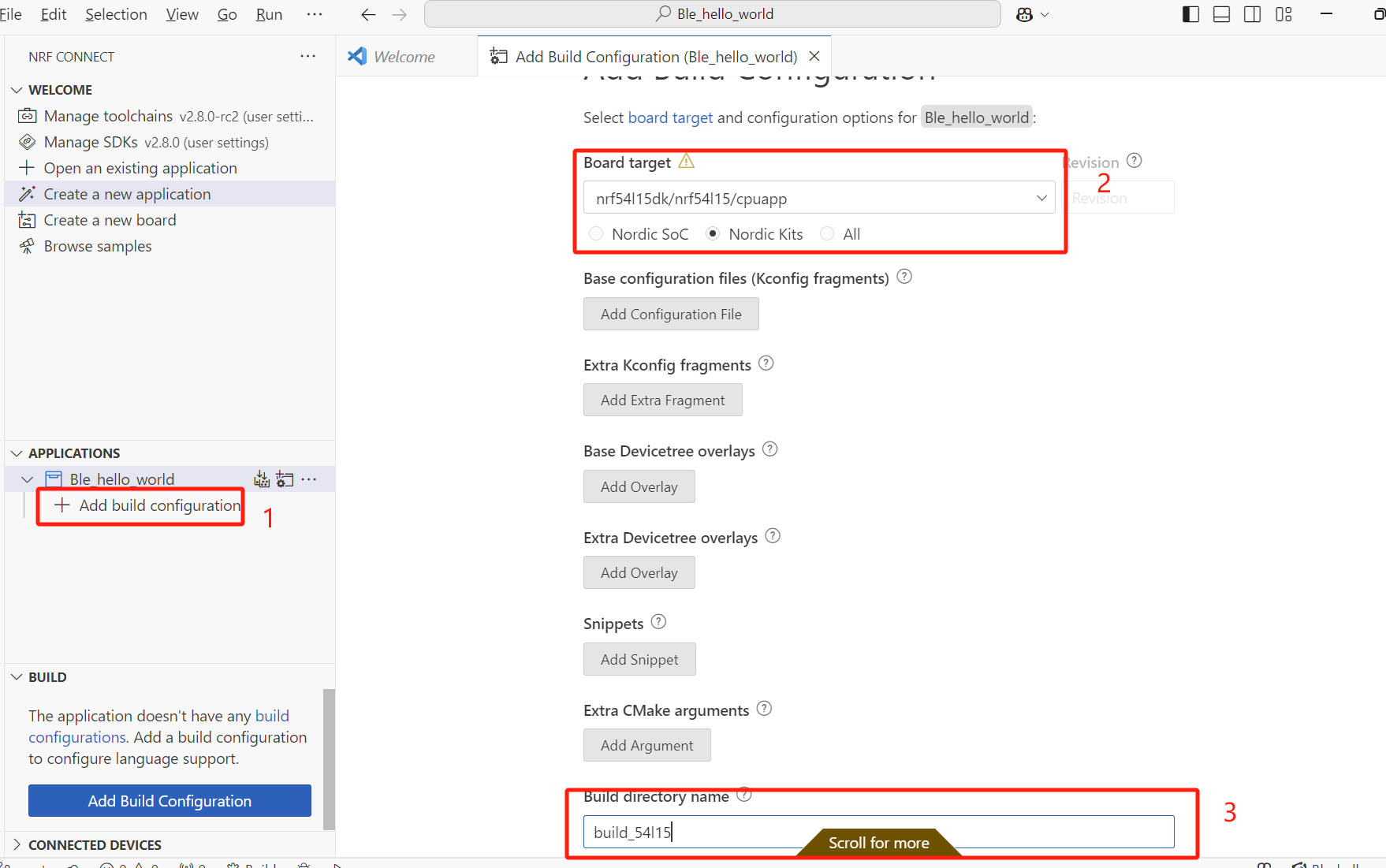
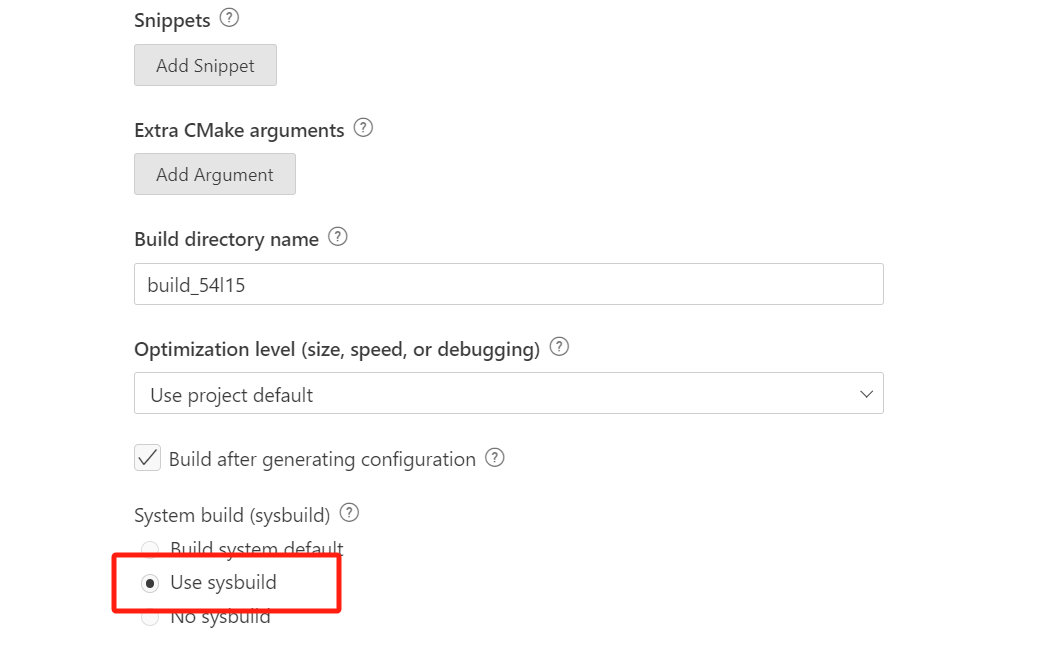
3、程序編譯之后下載到nRF54L15DK中,打開串口我們可以看到串口打印如下:
分別是NCS和Zephyr的版本,以及Hello World!和Boards的型號

4、我們打開這個工程的main.c,可以看到這個工程非常簡單,就是調用了printf來打印Hello World!和CONFIG_BOARD_TARGET這個宏
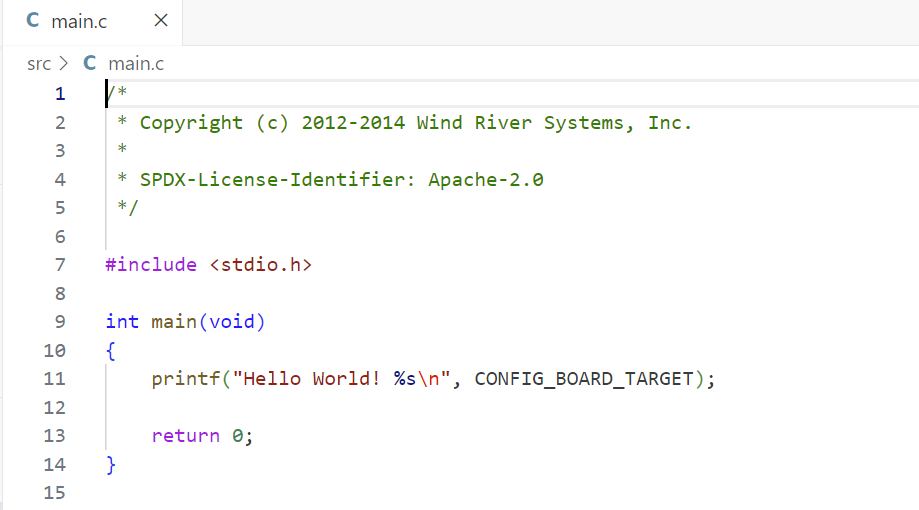
二、添加LOG模塊
上面的Hello World使用了printf來打印,在我們的程序里面可以調用LOG模塊來打印調試日志,這樣方便我們后續在產品量產的時候關閉LOG模塊
1、這里我們先在hello_world/prj.conf中下面這些的宏,開啟LOG
復制代碼
#Config logger
CONFIG_LOG=y
CONFIG_USE_SEGGER_RTT=n
CONFIG_LOG_BACKEND_RTT=n
CONFIG_LOG_BACKEND_UART=y
CONFIG_LOG_DEFAULT_LEVEL=3
復制代碼
2、在main.c中加入下面這些頭文件,調用LOG的庫,并注冊LOG模組
復制代碼
//Add Log Library file
#include
#include
//Register LOG Module
#define LOG_MODULE_NAME ble_hello_world
LOG_MODULE_REGISTER(LOG_MODULE_NAME);
復制代碼
3、這里我們提前寫一個bluetooth_init的函數,并在bluetooth_init中加入一些LOG信息
復制代碼
int bluetooth_init(void)
{
int err_code;
LOG_INF("Initiallzing BLE");
err_code = 0;
return err_code;
}
復制代碼
4、、在main函數中調用函數 bluetooth_init
復制代碼
int main(void)
{
int err_code;
err_code = bluetooth_init();
if(err_code){
LOG_ERR("Bluetooth_init returnrd %d", err_code)
}
printf("Hello World! %sn", CONFIG_BOARD_TARGET);
}
復制代碼
5、我們來編譯并下載程序到nRF54L15DK中會看到程序進入了bluetooth_init 并在串口打印了LOG:

三、使能協議棧
1、接下來,我們需要加入BLE相關的頭文件
//Add BLE Library file
#include
#include
#include
#include
2、prj.conf中加入這些宏,開啟BLE相關的宏
復制代碼
#Config BLE
CONFIG_BT=y
CONFIG_BT_PERIPHERAL=y
CONFIG_BT_DEVICE_NAME="BLE_Hello_World"
CONFIG_BT_DEVICE_APPEARANCE=0
CONFIG_BT_LL_SOFTDEVICE=y
CONFIG_BT_MAX_CONN=1
CONFIG_ASSERT=y
復制代碼
3、在 bluetooth_init中調用bt_enable,這是一個庫函數,這個函數的定義的bluetooth.h中,因為bt_enable只負責調度BLE協議棧的啟動,而在執行其他函數之前需要確保協議棧完成了啟動,所以我們要做一個簡單判斷
復制代碼
int bluetooth_init(void)
{
int err_code;
err_code = bt_enable(bt_ready_callback);
if(err_code)
{
LOG_ERR("BLE Enable returned %d",err_code);
return err_code;
}
LOG_INF("Initiallzing BLE");
return err_code;
}
復制代碼
3、我們去看一下這個函數的用法,這里看到bt_enable需要一個回調函數
復制代碼
/**
* @brief Enable Bluetooth
*
* Enable Bluetooth. Must be the called before any calls that
* require communication with the local Bluetooth hardware.
*
* When @kconfig{CONFIG_BT_SETTINGS} is enabled, the application must load the
* Bluetooth settings after this API call successfully completes before
* Bluetooth APIs can be used. Loading the settings before calling this function
* is insufficient. Bluetooth settings can be loaded with settings_load() or
* settings_load_subtree() with argument "bt". The latter selectively loads only
* Bluetooth settings and is recommended if settings_load() has been called
* earlier.
*
* @param cb Callback to notify completion or NULL to perform the
* enabling synchronously. The callback is called from the system workqueue.
*
* @return Zero on success or (negative) error code otherwise.
*/
int bt_enable(bt_ready_cb_t cb);
復制代碼
我們再去看bt_ready_cb_t這個參數的定義,從這個注釋中可以得知這個回調的作用是通知BLE已使能
復制代碼
/**
* @typedef bt_ready_cb_t
* @brief Callback for notifying that Bluetooth has been enabled.
*
* @param err zero on success or (negative) error code otherwise.
*/
typedef void (*bt_ready_cb_t)(int err);
復制代碼
所以為了確保BLE協議棧已經完成了使能,我們需要自己寫一個回調函數
復制代碼
/*BLE Enable Callback function*/
void bt_ready_callback(int err_code)
{
if(err_code)
{
LOG_ERR("BLE Enable callback returned %d",err_code);
}
}
復制代碼
4、這里我們在bluetooth_init中添加一個信號量,等待bt_ready_cb_t通知協議棧已使能,這里我們調用K_SEM_DEFINE初始化一個信號量,并將其計數設為 1、界限設為 1,然后在bluetooth_init中調用k_sem_take()獲取這個信號量,因為我們將計數設置為了1,所以程序會一直在bt_enable()這里等待協議棧使能完成,當然可以將K_FOREVER設置為一個時間,超時之后程序會繼續往下執行。
復制代碼
static K_SEM_DEFINE(ble_init_ok, 1, 1);
int bluetooth_init(void)
{
int err_code;
LOG_INF("Initiallzing BLE");
err_code = bt_enable(bt_ready_callback);
if(err_code)
{
LOG_ERR("BLE Enable returned %d",err_code);
return err_code;
}
k_sem_take(&ble_init_ok, K_FOREVER);return err_code;
}
復制代碼
因為這里我們要確保BLE協議棧使能完成,所以我們可以在bt_ready_callback()中釋放這個信號量,這樣我們可以通過信號量的同步得知BLE協議棧已經被使能。
復制代碼
/*BLE Enable Callback function*/
void bt_ready_callback(int err_code)
{
if(err_code)
{
LOG_ERR("BLE Enable callback returned %d",err_code);
}
k_sem_give(&ble_init_ok);
}
復制代碼
5、最后我們編譯看一下有什么效果,這里可以看到BLE協議棧已經被使能,并打印了版本信息等LOG
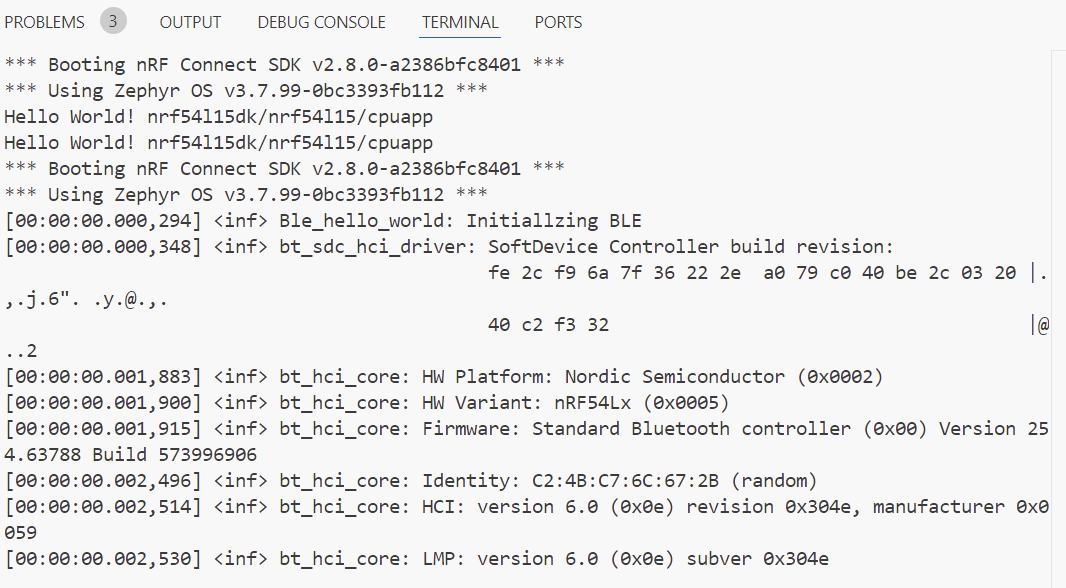
四、開啟廣播
使能BLE協議棧之后,我們接下來要做的就是開啟一個BLE廣播
1、我們來設置廣播包的內容,我們可以在廣播包中加入UUID,這里我們可以寫一個宏來定義UUID的號碼
/** @brief UUID of the Hello World Service. **/
#define BT_UUID_HOWD_VAL
BT_UUID_128_ENCODE(0x6e400001, 0xb5a3, 0xf393, 0xe0a9, 0xe50e24dcca9e)
#define BT_UUID_HOWD_SERVICE BT_UUID_DECLARE_128(BT_UUID_HOWD_VAL)
2、我們寫一個宏來設置廣播名稱,這個宏最終調用的是在prj.conf中CONFIG_BT_DEVICE_NAME的值,這里我的定義是CONFIG_BT_DEVICE_NAME="BLE_Hello_World"
/*Config BLE Device Name*/
#define DEVICE_NAME CONFIG_BT_DEVICE_NAME
#define DEVICE_NAME_LEN (sizeof(DEVICE_NAME) - 1)
3、最后我們把上面的UUID和名稱放在廣播包數據中,這里我把UUID放在了Scan response里面
復制代碼
/*Config BLE Advertising Data*/
static const struct bt_data ad[] = {
BT_DATA_BYTES(BT_DATA_FLAGS, (BT_LE_AD_GENERAL | BT_LE_AD_NO_BREDR)),
BT_DATA(BT_DATA_NAME_COMPLETE, DEVICE_NAME, DEVICE_NAME_LEN),
};
/*Config BLE Scan repsponse Data*/
static const struct bt_data srd[] = {
BT_DATA_BYTES(BT_DATA_UUID128_ALL, BT_UUID_HOWD_VAL),
};
復制代碼
4、完成廣播數據定義之后,我們就可以在bluetooth_init()中調用bt_le_adv_start()來開啟廣播了。
復制代碼
int bluetooth_init(void)
{
int err_code;
LOG_INF("Initiallzing BLE");
bt_conn_cb_register();
err_code = bt_enable(bt_ready_callback);
if(err_code)
{
LOG_ERR("BLE Enable returned %d",err_code);
return err_code;
}
k_sem_take(&ble_init_ok, K_FOREVER);
err_code = bt_le_adv_start(BT_LE_ADV_CONN, ad, ARRAY_SIZE(ad), srd,
ARRAY_SIZE(srd));
if (err_code) {
LOG_ERR("Advertising failed to start (err_code %d)", err_code);
return 0;
}
return err_code;
}
復制代碼
這里我們可以去看一下bt_le_adv_start()這個函數的用法,這是一個庫函數,可以在bluetooth.h中找到聲明,可以看到這個函數一共有5個入參,分別是
1)const struct bt_le_adv_param *param,是包括廣播周期、廣播類型等參數
2)const struct bt_data *ad, size_t ad_len,分別是廣播包數據和廣播包的長度
3)const struct bt_data *sd, size_t sd_len,分別是掃描響應包數據和掃描響應包的長度
1/**
2* @brief Start advertising
3*
4* Set advertisement data, scan response data, advertisement parameters
5* and start advertising.
6*
7* When the advertisement parameter peer address has been set the advertising
8* will be directed to the peer. In this case advertisement data and scan
9* response data parameters are ignored. If the mode is high duty cycle
10* the timeout will be @ref BT_GAP_ADV_HIGH_DUTY_CYCLE_MAX_TIMEOUT.
11*
12* This function cannot be used with @ref BT_LE_ADV_OPT_EXT_ADV in the @p param.options.
13* For extended advertising, the bt_le_ext_adv_* functions must be used.
14*
15* @param param Advertising parameters.
16* @param ad Data to be used in advertisement packets.
17* @param ad_len Number of elements in ad
18* @param sd Data to be used in scan response packets.
19* @param sd_len Number of elements in sd
20*
21* @return Zero on success or (negative) error code otherwise.
22* @return -ENOMEM No free connection objects available for connectable
23* advertiser.
24* @return -ECONNREFUSED When connectable advertising is requested and there
25* is already maximum number of connections established
26* in the controller.
27* This error code is only guaranteed when using Zephyr
28* controller, for other controllers code returned in
29* this case may be -EIO.
30*/
31intbt_le_adv_start(conststructbt_le_adv_param *param,
32conststructbt_data *ad, size_t ad_len,
33 conststructbt_data *sd, size_t sd_len);
在上面的代碼中,廣播參數也調用了一個現成的宏,這個宏在bluetooth.h中可以找到,在這個宏里面可以看到參數主義是定義了廣播類型為可連接廣播,快速廣播的最小周期和最大周期。此外廣播包中還定義了一下flag等,感興趣的讀者可以自行去看下面這幾個宏
BT_DATA_BYTES(BT_DATA_FLAGS, (BT_LE_AD_GENERAL | BT_LE_AD_NO_BREDR)
#define BT_LE_ADV_CONN BT_LE_ADV_PARAM(BT_LE_ADV_OPT_CONNECTABLE,
BT_GAP_ADV_FAST_INT_MIN_2,
BT_GAP_ADV_FAST_INT_MAX_2, NULL)
復制代碼
#define BT_GAP_ADV_FAST_INT_MIN_2 0x00a0 /* 100 ms */
#define BT_GAP_ADV_FAST_INT_MAX_2 0x00f0 /* 150 ms */
/**
* @brief Advertise as connectable.
*
* Advertise as connectable. If not connectable then the type of
* advertising is determined by providing scan response data.
* The advertiser address is determined by the type of advertising
* and/or enabling privacy @kconfig{CONFIG_BT_PRIVACY}.
*/
BT_LE_ADV_OPT_CONNECTABLE = BIT(0),
復制代碼
此外bluetooth.h中除了BT_LE_ADV_CONN BT_LE_ADV_PARAM之外,還有其他好多個廣播參數,感興趣的讀者可以去看看其他的宏分別定義了一些什么。
5、最后我們編譯工程來看一下有什么效果,我們可以使用nRF Connect app去查看一下廣播數據
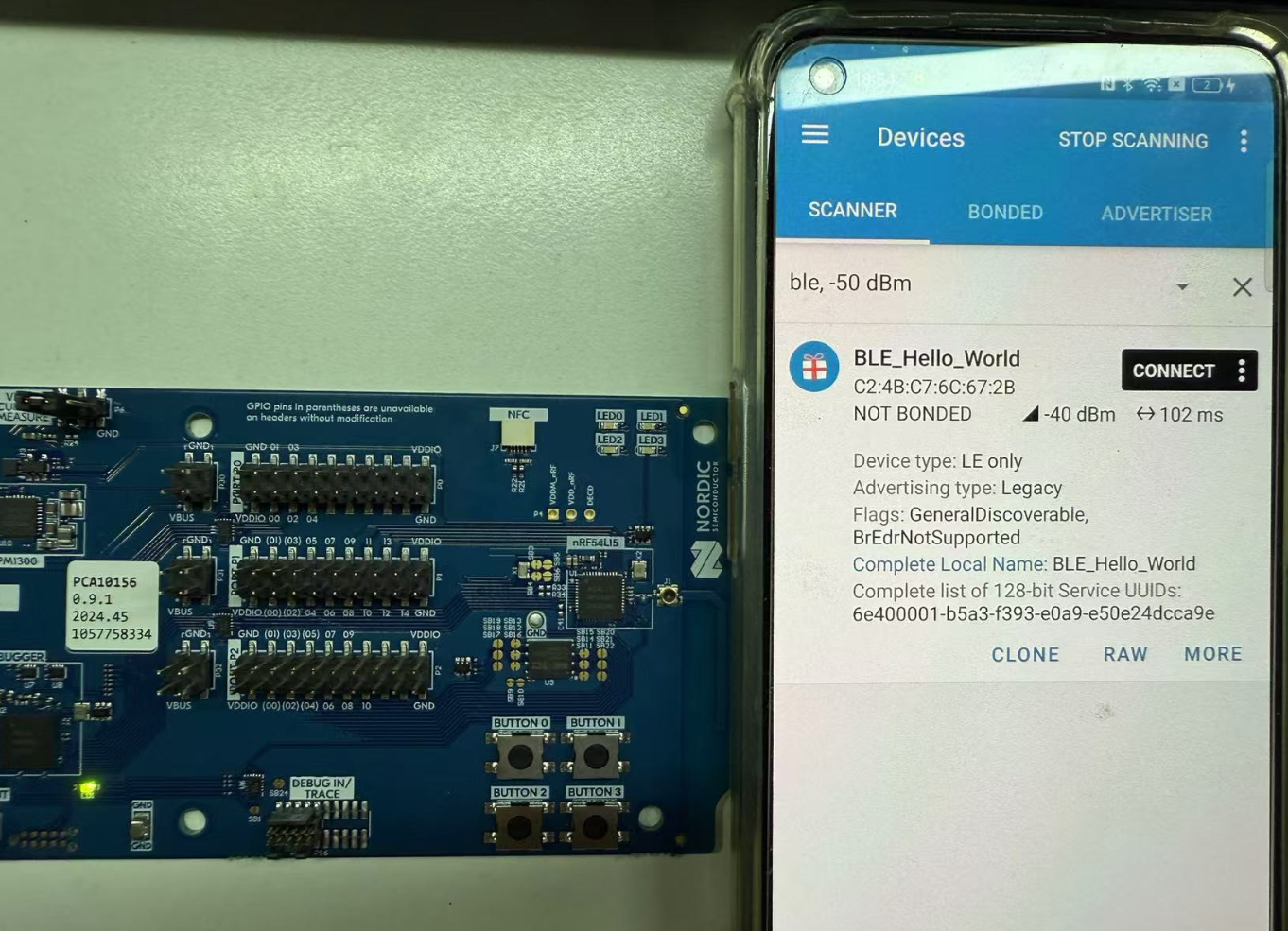
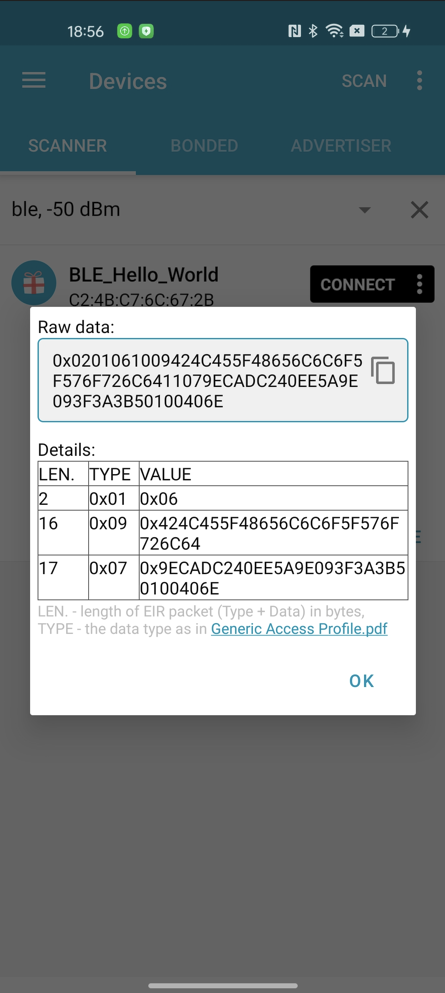
6、練習:如果你熟悉nRF5 SDK,你會發現在NCS上定義個廣播參數和廣播數據會比nRF5 SDK上要簡單,不需要去寫參數眾多的指針變量,甚至可以直接用現成定義好的宏,許多參數甚至可以直接在prj.conf中定義即可,這大大減少了代碼開發的工作量。這里感興趣的讀者可以去自行修改Appearance,這個參數可以通過下面這個宏來定義,修改這個宏的值然后在nRF Connect app的廣播設備的圖標會出現變化,SIG定義了一些標準具體的值,例如心率設備、HID設備等,具體去SIG這個網站查詢:https://www.bluetooth.com/specifications/assigned-numbers
CONFIG_BT_DEVICE_APPEARANCE=0
五、BLE的連接回調
在nRF5 SDK中BLE初始化的時候會注冊一個回調函數ble_evt_handler來處理BLE連接、斷開連接、更新PHY、Timeout等時候的中斷事件
復制代碼
/*nRF5 SDK中的BLE中斷事件*/
/**@brief Function for handling BLE events.
*
* @param[in] p_ble_evt Bluetooth stack event.
* @param[in] p_context Unused.
*/
static void ble_evt_handler(ble_evt_t const * p_ble_evt, void * p_context)
{
uint32_t err_code;
switch (p_ble_evt->header.evt_id)
{
case BLE_GAP_EVT_CONNECTED:
NRF_LOG_INFO("Connected");
err_code = bsp_indication_set(BSP_INDICATE_CONNECTED);
APP_ERROR_CHECK(err_code);
m_conn_handle = p_ble_evt->evt.gap_evt.conn_handle;
err_code = nrf_ble_qwr_conn_handle_assign(&m_qwr, m_conn_handle);
APP_ERROR_CHECK(err_code);
break;
case BLE_GAP_EVT_DISCONNECTED:
NRF_LOG_INFO("Disconnected");
// LED indication will be changed when advertising starts.
m_conn_handle = BLE_CONN_HANDLE_INVALID;
break;
case BLE_GAP_EVT_PHY_UPDATE_REQUEST:
{
NRF_LOG_DEBUG("PHY update request.");
ble_gap_phys_t const phys =
{
.rx_phys = BLE_GAP_PHY_AUTO,
.tx_phys = BLE_GAP_PHY_AUTO,
};
err_code = sd_ble_gap_phy_update(p_ble_evt->evt.gap_evt.conn_handle, &phys);
APP_ERROR_CHECK(err_code);
} break;
case BLE_GAP_EVT_SEC_PARAMS_REQUEST:
// Pairing not supported
err_code = sd_ble_gap_sec_params_reply(m_conn_handle, BLE_GAP_SEC_STATUS_PAIRING_NOT_SUPP, NULL, NULL);
APP_ERROR_CHECK(err_code);
break;
case BLE_GATTS_EVT_SYS_ATTR_MISSING:
// No system attributes have been stored.
err_code = sd_ble_gatts_sys_attr_set(m_conn_handle, NULL, 0, 0);
APP_ERROR_CHECK(err_code);
break;
case BLE_GATTC_EVT_TIMEOUT:
// Disconnect on GATT Client timeout event.
err_code = sd_ble_gap_disconnect(p_ble_evt->evt.gattc_evt.conn_handle,
BLE_HCI_REMOTE_USER_TERMINATED_CONNECTION);
APP_ERROR_CHECK(err_code);
break;
case BLE_GATTS_EVT_TIMEOUT:
// Disconnect on GATT Server timeout event.
err_code = sd_ble_gap_disconnect(p_ble_evt->evt.gatts_evt.conn_handle,
BLE_HCI_REMOTE_USER_TERMINATED_CONNECTION);
APP_ERROR_CHECK(err_code);
break;
default:
// No implementation needed.
break;
}
}
復制代碼
在NCS中,我們也可以這樣來做,這個章節我們將演示如何在連接和斷開連接的時候,打印LOG和點亮熄滅DK的LED1。
1、首先我們在bluetooth_init()加入一個回調注冊函數bt_conn_cb_register(),這個函數在conn.h,我們來看一下這個函數的聲明,可以看到這個函數的主要作用就是注冊一個callback用來在連接狀態下監控相關事件。
復制代碼
/** @brief Register connection callbacks.
*
* Register callbacks to monitor the state of connections.
*
* @param cb Callback struct. Must point to memory that remains valid.
*
* @retval 0 Success.
* @retval -EEXIST if @p cb was already registered.
*/
int bt_conn_cb_register(struct bt_conn_cb *cb);
復制代碼
從注釋中我們可以看到這個函數需要輸入 struct bt_conn_cb *cb 這個結構體作為入參,這個結構體的聲明也在conn.h中,我們去看一下這個結構體的注釋,可以看到這個結構體中給出的相關BLE回調函數是和nRF5 SDK中給出的case是相似的,感興趣的讀者可以自行查看注釋來進一步做對比。
復制代碼
/** @brief Connection callback structure.
*
* This structure is used for tracking the state of a connection.
* It is registered with the help of the bt_conn_cb_register() API.
* It's permissible to register multiple instances of this @ref bt_conn_cb
* type, in case different modules of an application are interested in
* tracking the connection state. If a callback is not of interest for
* an instance, it may be set to NULL and will as a consequence not be
* used for that instance.
*/
struct bt_conn_cb {
/** @brief A new connection has been established.
*
* This callback notifies the application of a new connection.
* In case the err parameter is non-zero it means that the
* connection establishment failed.
*
* @note If the connection was established from an advertising set then
* the advertising set cannot be restarted directly from this
* callback. Instead use the connected callback of the
* advertising set.
*
* @param conn New connection object.
* @param err HCI error. Zero for success, non-zero otherwise.
*
* @p err can mean either of the following:
* - @ref BT_HCI_ERR_UNKNOWN_CONN_ID Creating the connection started by
* @ref bt_conn_le_create was canceled either by the user through
* @ref bt_conn_disconnect or by the timeout in the host through
* @ref bt_conn_le_create_param timeout parameter, which defaults to
* @kconfig{CONFIG_BT_CREATE_CONN_TIMEOUT} seconds.
* - @p BT_HCI_ERR_ADV_TIMEOUT High duty cycle directed connectable
* advertiser started by @ref bt_le_adv_start failed to be connected
* within the timeout.
*/
void (*connected)(struct bt_conn *conn, uint8_t err);
/** @brief A connection has been disconnected.
*
* This callback notifies the application that a connection
* has been disconnected.
*
* When this callback is called the stack still has one reference to
* the connection object. If the application in this callback tries to
* start either a connectable advertiser or create a new connection
* this might fail because there are no free connection objects
* available.
* To avoid this issue it is recommended to either start connectable
* advertise or create a new connection using @ref k_work_submit or
* increase @kconfig{CONFIG_BT_MAX_CONN}.
*
* @param conn Connection object.
* @param reason BT_HCI_ERR_* reason for the disconnection.
*/
void (*disconnected)(struct bt_conn *conn, uint8_t reason);
/** @brief A connection object has been returned to the pool.
*
* This callback notifies the application that it might be able to
* allocate a connection object. No guarantee, first come, first serve.
*
* Use this to e.g. re-start connectable advertising or scanning.
*
* Treat this callback as an ISR, as it originates from
* @ref bt_conn_unref which is used by the BT stack. Making
* Bluetooth API calls in this context is error-prone and strongly
* discouraged.
*/
void (*recycled)(void);
/** @brief LE connection parameter update request.
*
* This callback notifies the application that a remote device
* is requesting to update the connection parameters. The
* application accepts the parameters by returning true, or
* rejects them by returning false. Before accepting, the
* application may also adjust the parameters to better suit
* its needs.
*
* It is recommended for an application to have just one of these
* callbacks for simplicity. However, if an application registers
* multiple it needs to manage the potentially different
* requirements for each callback. Each callback gets the
* parameters as returned by previous callbacks, i.e. they are not
* necessarily the same ones as the remote originally sent.
*
* If the application does not have this callback then the default
* is to accept the parameters.
*
* @param conn Connection object.
* @param param Proposed connection parameters.
*
* @return true to accept the parameters, or false to reject them.
*/
bool (*le_param_req)(struct bt_conn *conn,
struct bt_le_conn_param *param);
/** @brief The parameters for an LE connection have been updated.
*
* This callback notifies the application that the connection
* parameters for an LE connection have been updated.
*
* @param conn Connection object.
* @param interval Connection interval.
* @param latency Connection latency.
* @param timeout Connection supervision timeout.
*/
void (*le_param_updated)(struct bt_conn *conn, uint16_t interval,
uint16_t latency, uint16_t timeout);
#if defined(CONFIG_BT_SMP)
/** @brief Remote Identity Address has been resolved.
*
* This callback notifies the application that a remote
* Identity Address has been resolved
*
* @param conn Connection object.
* @param rpa Resolvable Private Address.
* @param identity Identity Address.
*/
void (*identity_resolved)(struct bt_conn *conn,
const bt_addr_le_t *rpa,
const bt_addr_le_t *identity);
#endif /* CONFIG_BT_SMP */
#if defined(CONFIG_BT_SMP) || defined(CONFIG_BT_CLASSIC)
/** @brief The security level of a connection has changed.
*
* This callback notifies the application that the security of a
* connection has changed.
*
* The security level of the connection can either have been increased
* or remain unchanged. An increased security level means that the
* pairing procedure has been performed or the bond information from
* a previous connection has been applied. If the security level
* remains unchanged this means that the encryption key has been
* refreshed for the connection.
*
* @param conn Connection object.
* @param level New security level of the connection.
* @param err Security error. Zero for success, non-zero otherwise.
*/
void (*security_changed)(struct bt_conn *conn, bt_security_t level,
enum bt_security_err err);
#endif /* defined(CONFIG_BT_SMP) || defined(CONFIG_BT_CLASSIC) */
#if defined(CONFIG_BT_REMOTE_INFO)
/** @brief Remote information procedures has completed.
*
* This callback notifies the application that the remote information
* has been retrieved from the remote peer.
*
* @param conn Connection object.
* @param remote_info Connection information of remote device.
*/
void (*remote_info_available)(struct bt_conn *conn,
struct bt_conn_remote_info *remote_info);
#endif /* defined(CONFIG_BT_REMOTE_INFO) */
#if defined(CONFIG_BT_USER_PHY_UPDATE)
/** @brief The PHY of the connection has changed.
*
* This callback notifies the application that the PHY of the
* connection has changed.
*
* @param conn Connection object.
* @param info Connection LE PHY information.
*/
void (*le_phy_updated)(struct bt_conn *conn,
struct bt_conn_le_phy_info *param);
#endif /* defined(CONFIG_BT_USER_PHY_UPDATE) */
#if defined(CONFIG_BT_USER_DATA_LEN_UPDATE)
/** @brief The data length parameters of the connection has changed.
*
* This callback notifies the application that the maximum Link Layer
* payload length or transmission time has changed.
*
* @param conn Connection object.
* @param info Connection data length information.
*/
void (*le_data_len_updated)(struct bt_conn *conn,
struct bt_conn_le_data_len_info *info);
#endif /* defined(CONFIG_BT_USER_DATA_LEN_UPDATE) */
#if defined(CONFIG_BT_DF_CONNECTION_CTE_RX)
/** @brief Callback for IQ samples report collected when sampling
* CTE received by data channel PDU.
*
* @param conn The connection object.
* @param iq_report Report data for collected IQ samples.
*/
void (*cte_report_cb)(struct bt_conn *conn,
const struct bt_df_conn_iq_samples_report *iq_report);
#endif /* CONFIG_BT_DF_CONNECTION_CTE_RX */
#if defined(CONFIG_BT_TRANSMIT_POWER_CONTROL)
/** @brief LE Read Remote Transmit Power Level procedure has completed or LE
* Transmit Power Reporting event.
*
* This callback notifies the application that either the remote transmit power level
* has been read from the peer or transmit power level has changed for the local or
* remote controller when transmit power reporting is enabled for the respective side
* using @ref bt_conn_le_set_tx_power_report_enable.
*
* @param conn Connection object.
* @param report Transmit power report.
*/
void (*tx_power_report)(struct bt_conn *conn,
const struct bt_conn_le_tx_power_report *report);
#endif /* CONFIG_BT_TRANSMIT_POWER_CONTROL */
#if defined(CONFIG_BT_PATH_LOSS_MONITORING)
/** @brief LE Path Loss Threshold event.
*
* This callback notifies the application that there has been a path loss threshold
* crossing or reporting the initial path loss threshold zone after using
* @ref bt_conn_le_set_path_loss_mon_enable.
*
* @param conn Connection object.
* @param report Path loss threshold report.
*/
void (*path_loss_threshold_report)(struct bt_conn *conn,
const struct bt_conn_le_path_loss_threshold_report *report);
#endif /* CONFIG_BT_PATH_LOSS_MONITORING */
#if defined(CONFIG_BT_SUBRATING)
/** @brief LE Subrate Changed event.
*
* This callback notifies the application that the subrating parameters
* of the connection may have changed.
* The connection subrating parameters will be unchanged
* if status is not BT_HCI_ERR_SUCCESS.
*
* @param conn Connection object.
* @param params New subrating parameters.
*/
void (*subrate_changed)(struct bt_conn *conn,
const struct bt_conn_le_subrate_changed *params);
#endif /* CONFIG_BT_SUBRATING */
#if defined(CONFIG_BT_CHANNEL_SOUNDING)
/** @brief LE CS Read Remote Supported Capabilities Complete event.
*
* This callback notifies the application that the remote channel
* sounding capabilities have been received from the peer.
*
* @param conn Connection object.
* @param remote_cs_capabilities Remote Channel Sounding Capabilities.
*/
void (*le_cs_remote_capabilities_available)(struct bt_conn *conn,
struct bt_conn_le_cs_capabilities *params);
/** @brief LE CS Read Remote FAE Table Complete event.
*
* This callback notifies the application that the remote mode-0
* FAE Table has been received from the peer.
*
* @param conn Connection object.
* @param params FAE Table.
*/
void (*le_cs_remote_fae_table_available)(struct bt_conn *conn,
struct bt_conn_le_cs_fae_table *params);
/** @brief LE CS Config created.
*
* This callback notifies the application that a Channel Sounding
* Configuration procedure has completed and a new CS config is created
*
* @param conn Connection object.
* @param config CS configuration.
*/
void (*le_cs_config_created)(struct bt_conn *conn, struct bt_conn_le_cs_config *config);
/** @brief LE CS Config removed.
*
* This callback notifies the application that a Channel Sounding
* Configuration procedure has completed and a CS config is removed
*
* @param conn Connection object.
* @param config_id ID of the CS configuration that was removed.
*/
void (*le_cs_config_removed)(struct bt_conn *conn, uint8_t config_id);
/** @brief Subevent Results from a CS procedure are available.
*
* This callback notifies the user that CS subevent results are
* available for the given connection object.
*
* @param conn Connection objects.
* @param result Subevent results
*/
void (*le_cs_subevent_data_available)(struct bt_conn *conn,
struct bt_conn_le_cs_subevent_result *result);
/** @brief LE CS Security Enabled.
*
* This callback notifies the application that a Channel Sounding
* Security Enable procedure has completed
*
* @param conn Connection object.
*/
void (*le_cs_security_enabled)(struct bt_conn *conn);
/** @brief LE CS Procedure Enabled.
*
* This callback notifies the application that a Channel Sounding
* Procedure Enable procedure has completed
*
* @param conn Connection object.
* @param params CS Procedure Enable parameters
*/
void (*le_cs_procedure_enabled)(
struct bt_conn *conn, struct bt_conn_le_cs_procedure_enable_complete *params);
#endif
/** @internal Internally used field for list handling */
sys_snode_t _node;
};
復制代碼
2、這里我們還是來演示如何使用CONNECT和DISCONNECT這兩個回調來在BLE斷開和連接的時候處理相關任務。首先我們來寫一個結構體ble_connection_callback ,這個結構體里面包括兩個函數ble_on_connected和ble_on_connected
struct bt_conn_cb ble_connection_callback = {
.connected = ble_on_connected,
.disconnected = ble_on_disconnected,
};
這里我們需要調用bt_conn_get_dst這個函數來獲取對端設備的MAC地址,并調用bt_addr_le_to_str將獲取到的地址轉成字符串用于打印。
復制代碼
/** @brief Get destination (peer) address of a connection.
*
* @param conn Connection object.
*
* @return Destination address.
*/
const bt_addr_le_t *bt_conn_get_dst(const struct bt_conn *conn);
/** @brief Converts binary LE Bluetooth address to string.
*
* @param addr Address of buffer containing binary LE Bluetooth address.
* @param str Address of user buffer with enough room to store
* formatted string containing binary LE address.
* @param len Length of data to be copied to user string buffer. Refer to
* BT_ADDR_LE_STR_LEN about recommended value.
*
* @return Number of successfully formatted bytes from binary address.
*/
static inline int bt_addr_le_to_str(const bt_addr_le_t *addr, char *str,
size_t len)
復制代碼
在連接和斷開異常的時候我們還可以調用bt_hci_err_to_str來獲取相關的錯誤代碼。
復制代碼
/** Converts a HCI error to string.
*
* The error codes are described in the Bluetooth Core specification,
* Vol 1, Part F, Section 2.
*
* The HCI documentation found in Vol 4, Part E,
* describes when the different error codes are used.
*
* See also the defined BT_HCI_ERR_* macros.
*
* @return The string representation of the HCI error code.
* If @kconfig{CONFIG_BT_HCI_ERR_TO_STR} is not enabled,
* this just returns the empty string
*/
#if defined(CONFIG_BT_HCI_ERR_TO_STR)
const char *bt_hci_err_to_str(uint8_t hci_err);
#else
static inline const char *bt_hci_err_to_str(uint8_t hci_err)
復制代碼
最后調用dk_set_led_on和dk_set_led_off來點亮和熄滅nRF54L15 DK的LED1。
3、接下來我們來寫ble_on_connected和ble_on_connected這兩個回調函數
復制代碼
static void ble_on_connected(struct bt_conn *conn, uint8_t err)
{
char addr[BT_ADDR_LE_STR_LEN];
/*Print err code when the connection is error*/
if (err) {
LOG_ERR("Connection failed, err 0x%02x %s", err, bt_hci_err_to_str(err));
return;
}
/*Print the MAC address of Central Deevice*/
bt_addr_le_to_str(bt_conn_get_dst(conn), addr, sizeof(addr));
LOG_INF("Connected %s", addr);
/*Count the coennection*/
current_conn = bt_conn_ref(conn);
dk_set_led_on(DK_LED1)
);
}
復制代碼
復制代碼
static void ble_on_disconnected(struct bt_conn *conn, uint8_t reason)
{
char addr[BT_ADDR_LE_STR_LEN];
/*Get the MAC address of central and print it when the connection is disconnected*/
bt_addr_le_to_str(bt_conn_get_dst(conn), addr, sizeof(addr));
LOG_INF("Disconnected: %s, reason 0x%02x %s", addr, reason, bt_hci_err_to_str(reason));
/*Decrement a connection's reference count and off LED1 of DK*/
if (current_conn) {
bt_conn_unref(current_conn);
current_conn = NULL;
dk_set_led_off(DK_LED1);
}
}
復制代碼
這里我們引入了一個全局變量current_conn用于計數已連接的設備數量,所以需要做一個聲明
static struct bt_conn *current_conn;
此外我們調用了LED1這個外設用來指示BLE的連接情況,所以我們還需要在main中初始化LED1這個外設,這里我們需要加入一些頭文件并在prj.conf中使能相關的宏,最后在main中調用configure_gpio。
//Add LED and Button drivers Library file
#include
# Enable DK LED and Buttons library
CONFIG_DK_LIBRARY=y
CONFIG_GPIO=y
復制代碼
static void configure_gpio(void)
{
int err_code;
err_code = dk_leds_init();
if (err_code) {
LOG_ERR("Cannot init LEDs (err: %d)", err_code);
}
}
復制代碼
4、完成上述步驟之后,我們將ble_connection_callback這個函數注冊到bluetooth_init中
復制代碼
int bluetooth_init(struct bt_conn_cb *ble_cb)
{
int err_code;
LOG_INF("Initiallzing BLE");
if (ble_cb == NULL)
{
return -NRFX_ERROR_NULL;
}
bt_conn_cb_register(ble_cb);
err_code = bt_enable(bt_ready_callback);
if(err_code)
{
LOG_ERR("BLE Enable returned %d",err_code);
return err_code;
}
k_sem_take(&ble_init_ok, K_FOREVER);
err_code = bt_le_adv_start(BT_LE_ADV_CONN, ad, ARRAY_SIZE(ad), srd,
ARRAY_SIZE(srd));
if (err_code) {
LOG_ERR("Advertising failed to start (err_code %d)", err_code);
return 0;
}
return err_code;
}
復制代碼
復制代碼
int main(void)
{
int err_code;
configure_gpio();
err_code = bluetooth_init(&ble_connection_callback);
if(err_code)
{
LOG_ERR("Bluetooth_init returnrd %d", err_code);
}
printf("Hello World! %sn", CONFIG_BOARD_TARGET);
}
復制代碼
5、最后我們編譯下載工程到nRF54L15的DK中,使用nRF Connect APP連接可以看到連接和斷開之后分別打印了手機端的MAC地址

同時DK的LED1在連接之后常亮
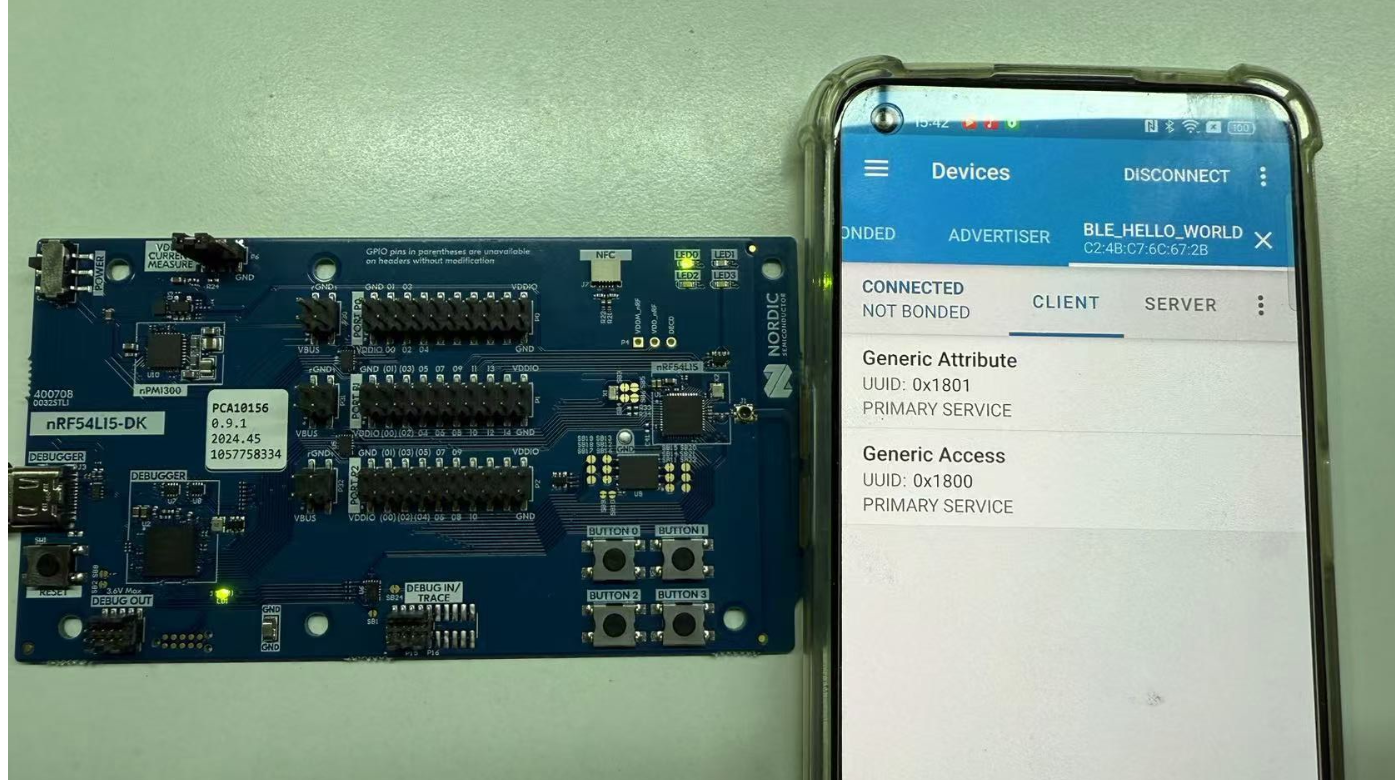
六、添加一個Service
1、從上面的圖片中可以看到,APP連接nRF54L15 DK之后只有一些通用的Service,這一步我們來演示如何添加一個自定義的Service,在nRF5 SDK中我們需要在service_init中初始化給相關的指針寫入值,但在NCS中我們可以直接調用BT_GATT_SERVICE_DEFINE來實現
復制代碼
/**
* @brief Statically define and register a service.
*
* Helper macro to statically define and register a service.
*
* @param _name Service name.
*/
#define BT_GATT_SERVICE_DEFINE(_name, ...)
const struct bt_gatt_attr attr_##_name[] = { __VA_ARGS__ };
const STRUCT_SECTION_ITERABLE(bt_gatt_service_static, _name) =
BT_GATT_SERVICE(attr_##_name)
#define _BT_GATT_ATTRS_ARRAY_DEFINE(n, _instances, _attrs_def)
static struct bt_gatt_attr attrs_##n[] = _attrs_def(_instances[n])
#define _BT_GATT_SERVICE_ARRAY_ITEM(_n, _) BT_GATT_SERVICE(attrs_##_n)
復制代碼
2、這里我直接用了NUS服務的UUID,當然你可以自己定義一個UUID看一下有什么效果
復制代碼
/** @brief UUID of the NUS Service. **/
#define BT_UUID_HOWD_VAL
BT_UUID_128_ENCODE(0x6e400001, 0xb5a3, 0xf393, 0xe0a9, 0xe50e24dcca9e)
#define BT_UUID_HOWD_SERVICE BT_UUID_DECLARE_128(BT_UUID_HOWD_VAL)
#define SERVICE_NAME nus_svc
BT_GATT_SERVICE_DEFINE(SERVICE_NAME,
BT_GATT_PRIMARY_SERVICE(BT_UUID_HOWD_SERVICE)
);
復制代碼
3、最后編譯一下工程下載的nRF54L15DK,并使用nRF Connect APP連接中可以看到多了一個NUS服務。

七、添加特征值并定義其屬性
1、完成上述步驟之后,BLE多了一個Service,但是這個Service中沒有Characteristic(特征值),這里我們還可以在BT_GATT_SERVICE_DEFINE中調用BT_GATT_CHARACTERISTIC,將特征值放在Service下面,這個結構就像APP上Service下面有特征值那樣,非常直觀。這里我們去看一下BT_GATT_CHARACTERISTIC,會發現它一共有6個入參
1)_uuid是特征值的UUID
2)_props是特征值的屬性,比如:read,write,Notify,indicate等
3)_perm是屬性的訪問權限,比如:普通、加密、配對等
4)_read、_write是分別是讀取和寫入的回調函數
5)_user_data是留給用戶自定義的一些數據,一般不用
復制代碼
/**
* @brief Characteristic and Value Declaration Macro.
*
* Helper macro to declare a characteristic attribute along with its
* attribute value.
*
* @param _uuid Characteristic attribute uuid.
* @param _props Characteristic attribute properties,
* a bitmap of ``BT_GATT_CHRC_*`` macros.
* @param _perm Characteristic Attribute access permissions,
* a bitmap of @ref bt_gatt_perm values.
* @param _read Characteristic Attribute read callback
* (@ref bt_gatt_attr_read_func_t).
* @param _write Characteristic Attribute write callback
* (@ref bt_gatt_attr_write_func_t).
* @param _user_data Characteristic Attribute user data.
*/
#define BT_GATT_CHARACTERISTIC(_uuid, _props, _perm, _read, _write, _user_data)
BT_GATT_ATTRIBUTE(BT_UUID_GATT_CHRC, BT_GATT_PERM_READ,
bt_gatt_attr_read_chrc, NULL,
((struct bt_gatt_chrc[]) {
BT_GATT_CHRC_INIT(_uuid, 0U, _props),
})),
BT_GATT_ATTRIBUTE(_uuid, _perm, _read, _write, _user_data)
復制代碼
2、這里因為我們這個特征值的屬性是Read,所以我們需要在寫一個回調,在里面將Button的鍵值通過GATT接口發送出去,這需要用到一個庫函數bt_gatt_attr_read,這個函數的聲明在gatt.h中,可以看到這個函數的作用是將本地數據通過Read屬性上傳
復制代碼
/** @brief Generic Read Attribute value helper.
*
* Read attribute value from local database storing the result into buffer.
*
* @param conn Connection object.
* @param attr Attribute to read.
* @param buf Buffer to store the value.
* @param buf_len Buffer length.
* @param offset Start offset.
* @param value Attribute value.
* @param value_len Length of the attribute value.
*
* @return number of bytes read in case of success or negative values in
* case of error.
*/
ssize_t bt_gatt_attr_read(struct bt_conn *conn, const struct bt_gatt_attr *attr,
void *buf, uint16_t buf_len, uint16_t offset,
const void *value, uint16_t value_len);
復制代碼
3、我們來嘗試加一個Read屬性的特征值,讀取按鍵DK上按下的Button的鍵值,從BT_GATT_CHARACTERISTIC的注釋中可以看到,要使用這個宏需要寫一個回調函數,首先來聲明以下這個回調函數,并將bt_gatt_attr_read的入參作為回調函數的入參
ssize_t read_button_characteristic_cb(struct bt_conn *conn, const struct bt_gatt_attr *attr,
void *buf, uint16_t len, uint16_t offset);
這個函數的實際功能是在Read這個特征值的時候,將鍵值上傳給GATT,所以我們來定義一個全局變量來獲取button的鍵值
static uint8_t button_value = 0;
然后將button_value通過bt_gatt_attr_read上傳給GATT
復制代碼
ssize_t read_button_characteristic_cb(struct bt_conn *conn, const struct bt_gatt_attr *attr,
void *buf, uint16_t len, uint16_t offset)
{
return bt_gatt_attr_read(conn, attr, buf, len, offset, &button_value, sizeof(button_value));
}
復制代碼
4、將這個回調放入BT_GATT_CHARACTERISTIC中,并寫入這個Read特征值的屬性等相關配置。
這里的特征值的UUID我用了NUS服務TX的特征值;
BT_GATT_CHRC_READ表示特征值的屬性是Read
BT_GATT_PERM_READ表示特征值的訪問權限為普通讀取
讀取的回調使用我們寫好的read_button_characteristic_cb這個函數
因為這個特征值只是Read屬性,所以不需要Write的回調,也不需要用戶自定義數據,所以最后兩個入參填寫為NULL
復制代碼
#define BT_UUID_NUS_TX_VAL
BT_UUID_128_ENCODE(0x6e400003, 0xb5a3, 0xf393, 0xe0a9, 0xe50e24dcca9e)
#define BT_UUID_NUS_TX BT_UUID_DECLARE_128(BT_UUID_NUS_TX_VAL)
BT_GATT_SERVICE_DEFINE(SERVICE_NAME,
BT_GATT_PRIMARY_SERVICE(BT_UUID_NUS_SERVICE),
BT_GATT_CHARACTERISTIC(BT_UUID_NUS_TX,
BT_GATT_CHRC_READ,
BT_GATT_PERM_READ,
read_button_characteristic_cb, NULL, NULL),
);
復制代碼
GATT的屬性和權限除了上述兩個參數之外,還有其他類型,感興趣的讀者具體可以去gatt.h中查看相關注釋說明。
5、至此我們已經完成了BLE數據上傳部分的代碼編寫,接下來我們來讀取Button的鍵值,并將這個值給到全局變量button_value即可。這里我們寫一個函數來傳遞button的鍵值
void set_button_value(uint8_t btn_value)
{
button_value = btn_value;
}
我們還需要通過GPIO外設來讀取鍵值,和點亮LED一樣,需要先將DK的Button初始化,這里要調用dk_buttons_init來完成,它是一個庫函數,函數聲明在dk_buttons_and_leds.h中。
復制代碼
/** @brief Initialize the library to read the button state.
*
* @param button_handler Callback handler for button state changes.
*
* @retval 0 If the operation was successful.
* Otherwise, a (negative) error code is returned.
*/
int dk_buttons_init(button_handler_t button_handler);
/**
* @typedef button_handler_t
* @brief Callback that is executed when a button state change is detected.
*
* @param button_state Bitmask of button states.
* @param has_changed Bitmask that shows which buttons have changed.
*/
typedef void (*button_handler_t)(uint32_t button_state, uint32_t has_changed);
復制代碼
從注釋可以看到這個函數需要一個button的回調函數,用于處理button時候的中斷。我們來寫這個回調,在里面處理不同按鍵按下之后,定義不同的鍵值,并通過LOG打印鍵值,最后調用set_button_value將鍵值傳遞給全局變量button_value。
復制代碼
void button_handler(uint32_t button_state, uint32_t has_changed)
{
int button_pressed = 0;
if (has_changed & button_state) {
if (DK_BTN1_MSK & has_changed) {
button_pressed = 1;
}
if (DK_BTN2_MSK & has_changed) {
button_pressed = 2;
}
if (DK_BTN3_MSK & has_changed) {
button_pressed = 3;
}
if (DK_BTN4_MSK & has_changed) {
button_pressed = 4;
}
LOG_INF("Button %d pressed", button_pressed);
set_button_value(button_pressed);
}
}
復制代碼
最后在GPIO初始化里面調用dk_buttons_init并寫入回調函數button_handler即可。
復制代碼
static void configure_gpio(void)
{
int err_code;
err_code = dk_buttons_init(button_handler);
if (err_code) {
LOG_ERR("Cannot init buttons (err: %d)", err_code);
}
err_code = dk_leds_init();
if (err_code) {
LOG_ERR("Cannot init LEDs (err: %d)", err_code);
}
}
復制代碼
6、最后編譯工程,并使用nRF Connect APP連接nRF54L15DK的廣播,可以看到NUS Service下多了一個Read屬性,當我們按下DK上的Button的時候,可以讀取到對應的鍵值。
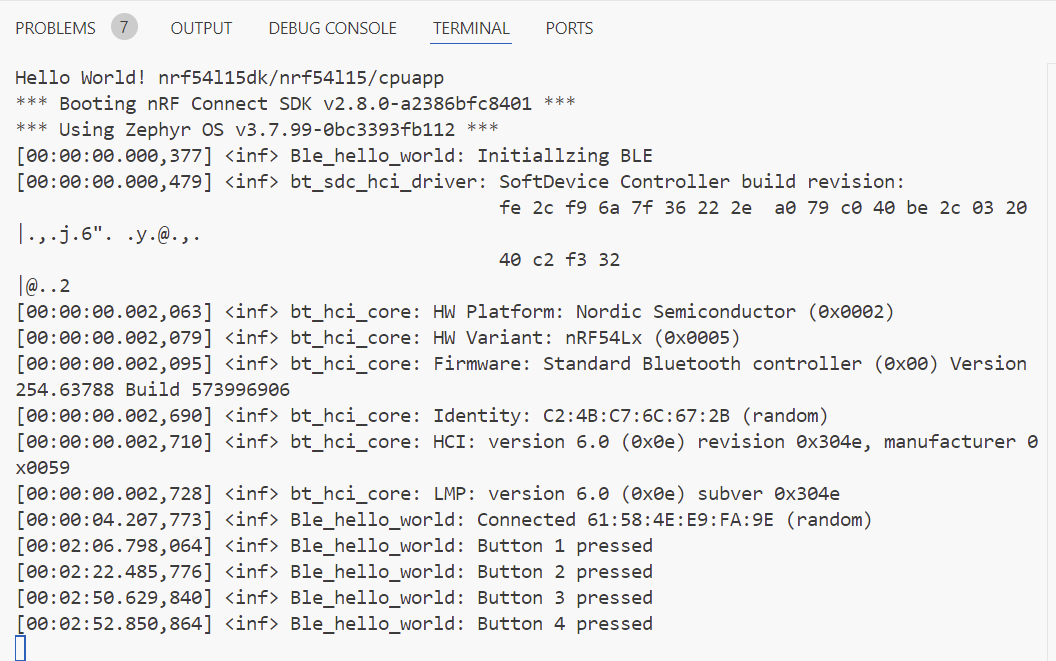

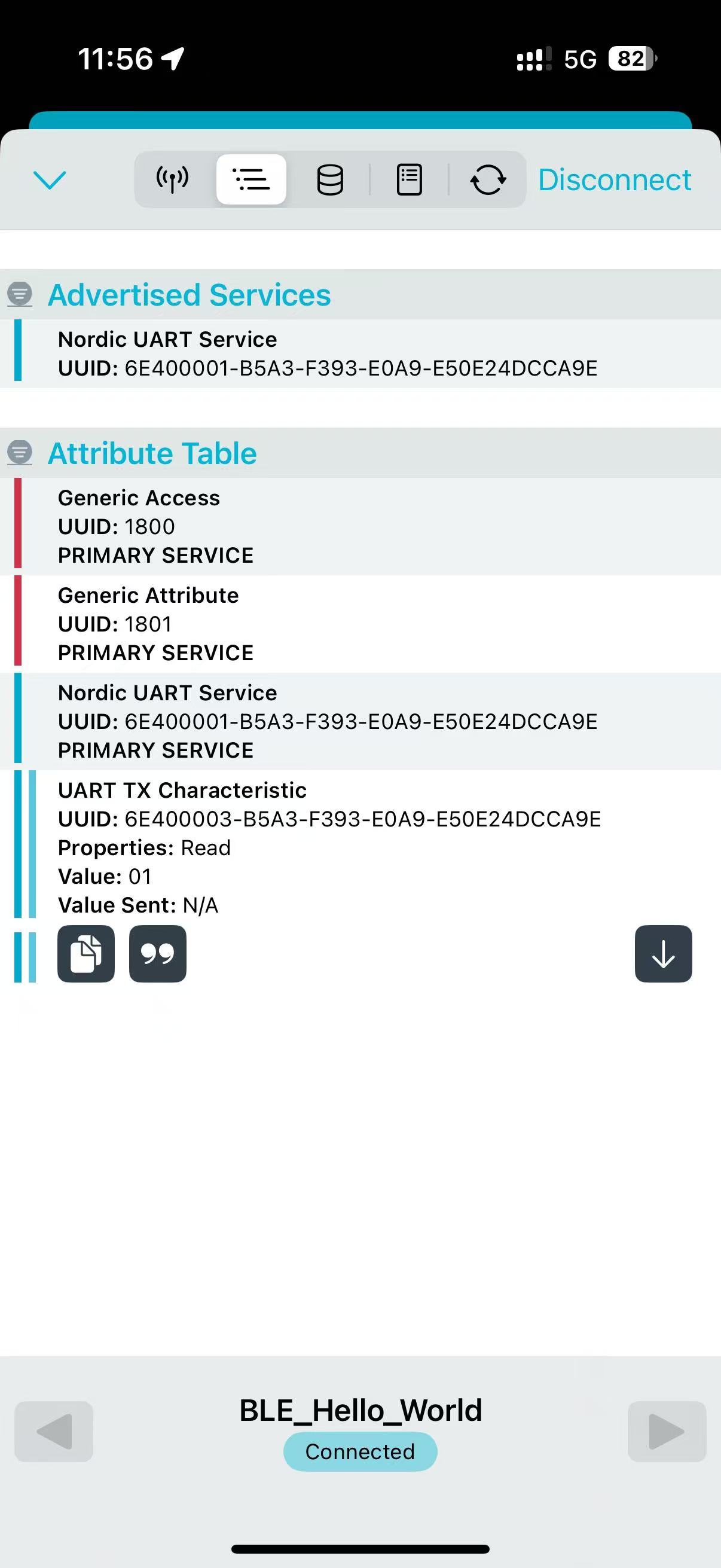
持續未完........
上一篇:nRF Connect SDK(NCS)/Zephyr固件升級詳解 – 重點講述MCUboot和藍牙空中升級
審核編輯 黃宇
-
開發板
+關注
關注
25文章
5622瀏覽量
103605 -
BLE
+關注
關注
12文章
697瀏覽量
60578 -
Nordic
+關注
關注
9文章
208瀏覽量
48034
發布評論請先 登錄





 從零開始手把手教你寫一個基于nRF54L15的BLE工程
從零開始手把手教你寫一個基于nRF54L15的BLE工程

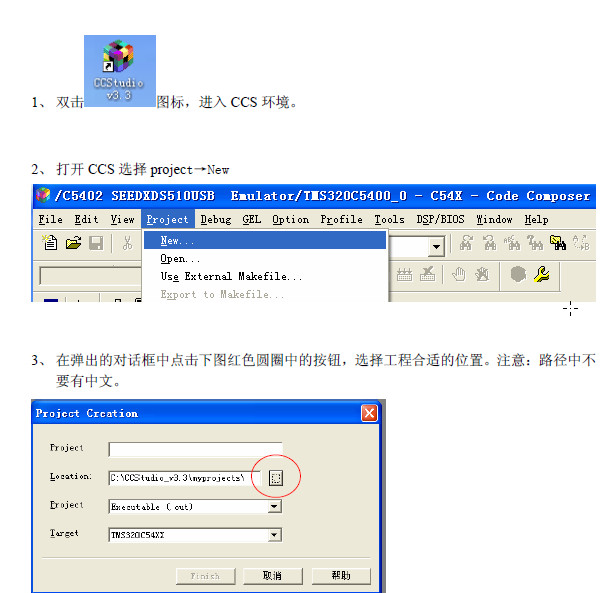











評論